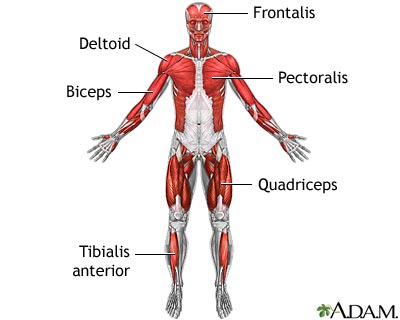Polymyositis - symptoms, treatment, and prognosis

Polymyositis is a chronic condition of widespread INFLAMMATION of the muscles. The inflammation causes weakness and difficulty with everyday movements including walking, reaching for objects, bathing, and dressing. Polymyositis is a type of inflammatory MYOPATHY that many researchers believe is autoimmune in its origins. Other researchers believe polymyositis and other inflammatory myopathies develop after viral INFECTION or as side effects of cholesterol-lowering therapy with statin medications. Polymyositis has alternating periods of RECURRENCE and REMISSION that tend to be lifelong. Most people are age 50 or older when they develop the condition.
Symptoms of Polymyositis and Diagnostic Path
The severity and range of symptoms vary among individuals as well as across episodes within the same person. Symptoms of polymyositis may include
- MUSCLE weakness throughout the body though most pronounced in the shoulders, upper arms, hips, and thighs
- both sides of the body equally affected
- JOINT PAIN
- fatigue
- difficulty swallowing
The diagnostic path includes BLOOD tests to detect antibodies and elevated enzymes that indicate muscle injury within the body. Muscle biopsy may show the inflammation within the sample of muscle tissue. Sometimes MAGNETIC RESONANCE IMAGING (MRI) presents a pattern of the inflammation’s presence in the body. Because there are no conclusive diagnostic tests for polymyositis, the diagnostic journey can be arduous and frustrating.
Polymyositis Treatment Options and Outlook
Treatment for polymyositis is a combination of CORTICOSTEROID MEDICATIONS and IMMUNOSUPPRESSIVE MEDICATIONS, which work together to mitigate the IMMUNE SYSTEM’s inflammatory response. Physical therapy for passive and active range of motion exercises helps maintain optimal joint function. Daily physical activity has similar effect. Polymyositis is a lifelong condition that, when symptoms are severe, can result in permanent disability.
Polymyositis -Risk Factors and Preventive Measures
Because researchers do not know what causes polymyositis, there are no known measures to prevent its development. Early diagnosis and treatment offer the most effective approach for minimizing the course of the disease and reducing the seriousness of its symptoms.
See also ANTIBODY; AUTOIMMUNE DISORDERS; CHRONIC PAIN; QUALITY OF LIFE; SYSTEMIC LUPUS ERYTHEMATOSUS (SLE); VIRUS.
Open discussion on the topic Polymyositis - definition, symptoms, treatment, and prognosis
Similar interests
- Casino Non Aams
- Nuovi Casino
- Casinos Not On Gamstop
- UK Casinos Not On Gamstop
- Casinos Not On Gamstop
- UK Casinos Not On Gamstop
- Casino Non Aams Italia
- Slot Sites Not On Gamstop
- Meilleur Casino En Ligne
- Non Gamstop Casino Sites UK
- Meilleur Casino En Ligne
- Casino En Ligne France
- Best Non Gamstop Casinos
- Casinos Not On Gamstop
- UK Casino Not On Gamstop
- Casinos Not Signed Up To Gamstop
- Best Slot Sites UK
- Non Gamstop Casino Sites UK
- Online Casinos Nederland
- Online Casinos Nederland
- Casinos Not On Gamstop
- Best New Uk Casinos Not On Gamstop
- Casino Non Aams
- Non Gamstop Casinos UK
- Migliori Siti Casino Non Aams
- Bitcoin Casinos
- Sites De Paris Sportifs Belgique
- Bookmaker Non Aams
- Casino En Ligne
- Casino Nouveau En Ligne